- Cancer Institute
- Cancer Research
- Cancer Registries
- Mississippi Cancer Registry
- Data and Statistics
- Lifestyle-Related Cancers
Lifestyle-Related Cancers
- Cancer Center and Research Institute
- Contact Cancer Center and Research Institute
-
Cancer Research
- Cancer Research Overview
-
Cancer Registries
- Cancer Registries Home
- UMMC Cancer Registry
- Mississippi Cancer Registry
- Clinical Trials
- Programs
- For Students and Trainees
- Patient Support
- Give Now
- In the News
- Contact Cancer Center and Research Institute
- CCRI Leadership
Alcohol-related Cancers in Mississippi, 2003-2021
Excess alcohol consumption is a modifiable risk factor that increases the risk of developing certain cancers. According to data from the Behavioral Risk Factor Surveillance System for 2022, 13.6% of Mississippi adults ages 21 and older reported binge drinking (men having more than five drinks on one occasion and women having more than four drinks on one occasion). Mississippi has the seventh lowest rate of binge drinking among the US states, District of Columbia and Puerto Rico.1 Excessive alcohol use is associated with cancers of the lip, oral cavity, pharynx, colon and rectum, breast in females, esophagus, liver and larynx. Below are graphs of the trends in alcohol-related cancers over the period 2003 to 2021 by race and sex with a description of the trends occurring in each group and a comparison of rates between groups for the most recent time period of 2017 to 2021. All analysis was done using SEER*Stat software2.
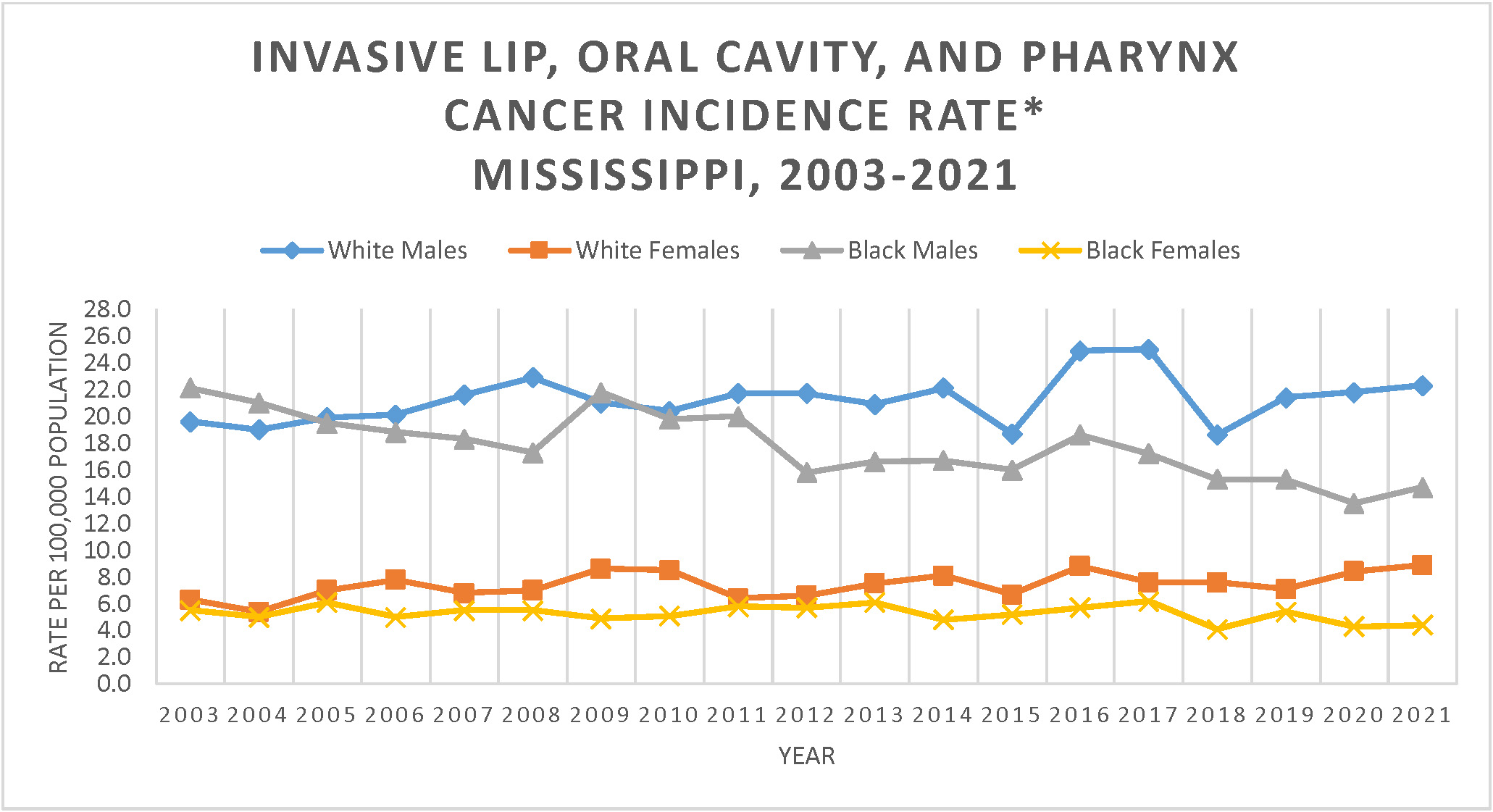
While lip, oral cavity and pharynx cancer is associated with excessive alcohol use, it is also associated with another modifiable risk factor, tobacco use. Cancers of the oropharynx may also be associated with Human Papillomavirus (HPV) infection. Males had significantly higher rates of lip, oral cavity and pharynx cancers than females. Over the period from 2003 to 2021, only black males experienced a significant change in incidence rates. The rate for black males decreased annually by 2.02%. The rate for black females was also decreasing at an observed rate of 0.65%. The rates for white males and white females were observed to be increasing. The rate for white males increased at a rate of 0.58% annually and the rate for white females increased at a rate of 1.20% annually.
For the latest five-year time period of 2017 to 2021, black males, black females and white females had a similar trend to that of the overall time period of 2003 to 2021. Though not statistically significant, the rate for black males was decreasing at a rate of 4.27% annually and the rate for black females was decreasing at a rate of 7.09% annually. The rate for white females increased at an observed rate of 4.30% annually. White males had an opposite trend compared to the full time period of 2003 to 2021. Though not statistically significant, the rate for white males decreased at a rate of 1.24% annually.
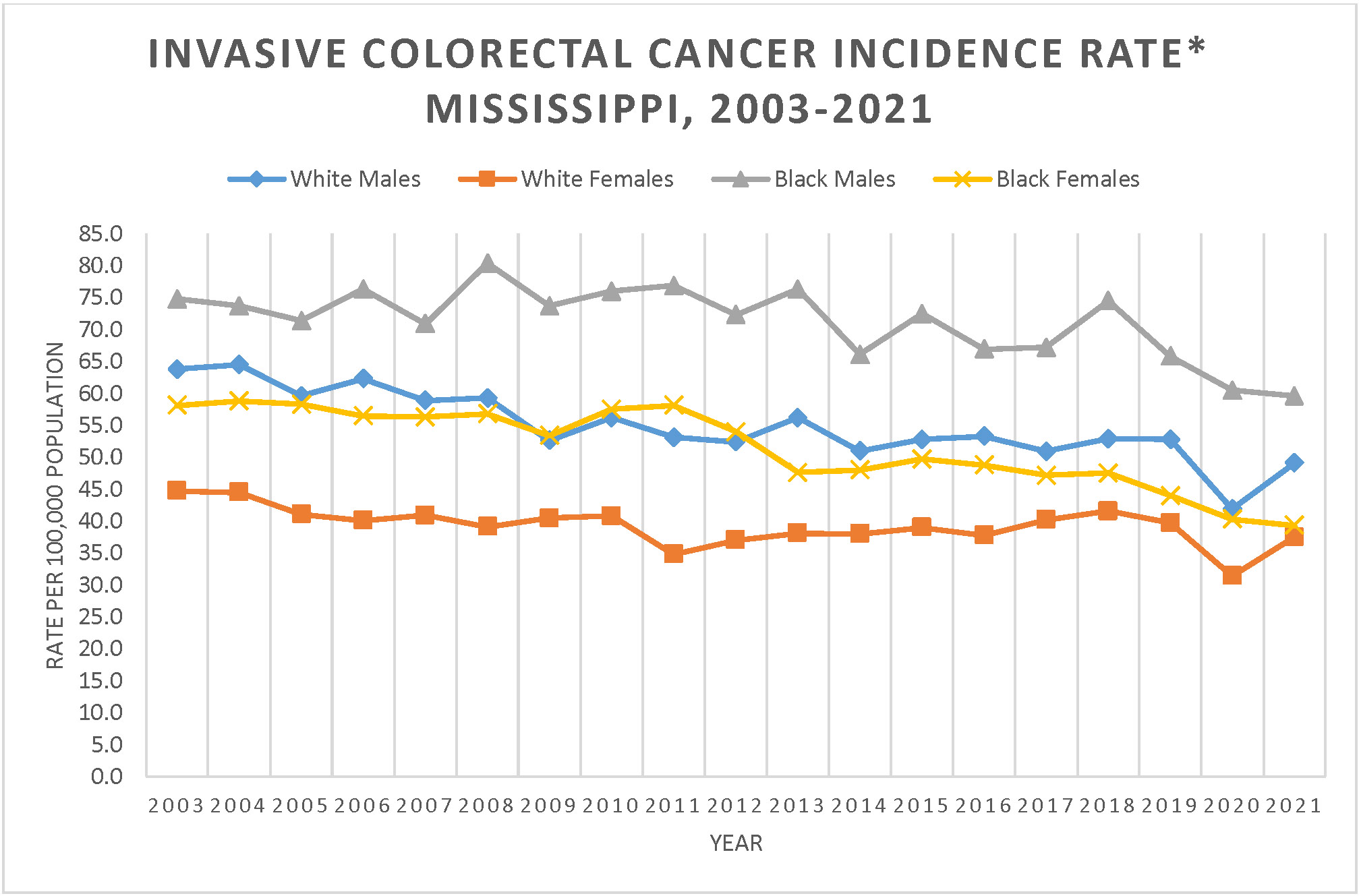
While colorectal cancer is associated with alcohol use, it is also associated with other modifiable risk factors, tobacco use (both colon and rectum cancers), obesity (both colon and rectum cancers) and lack of physical activity (only colon cancer). Black males had significantly higher rates of colorectal cancer than all other groups except for in years 2003 and 2004 where their rates were similar to those of white males. Colorectal cancer rates decreased significantly in all groups except black males for the period between 2003 and 2021. White females had a significant decrease of 0.79% annually and white males had a significant decrease of 1.53% annually. Black females experienced an annual observed decrease of 0.64% between 2003 and 2011, followed by a significant decrease annually of 3.04% between 2011 and 2021. These patterns translate into a significant average annual percent decrease of 2.0% for black females over the full time period. Between 2003 and 2018, black males had an observed decrease of 0.51% annually. Between 2018 and 2021, black males experienced a significant decrease of 6.01% annually. These patterns translate into an observed average annual decrease of 1.4% for black males over the full time period.
For the latest five-year period of 2017 to 2021, all groups experienced an observed decrease, but only black females experienced a significant decrease. Black females had a significant annual decrease of 5.18%. For black males, the observed annual rate of decrease was 4.47%. White females had an observed annual decrease of 3.775 and white males had an observed annual decrease of 2.82%.
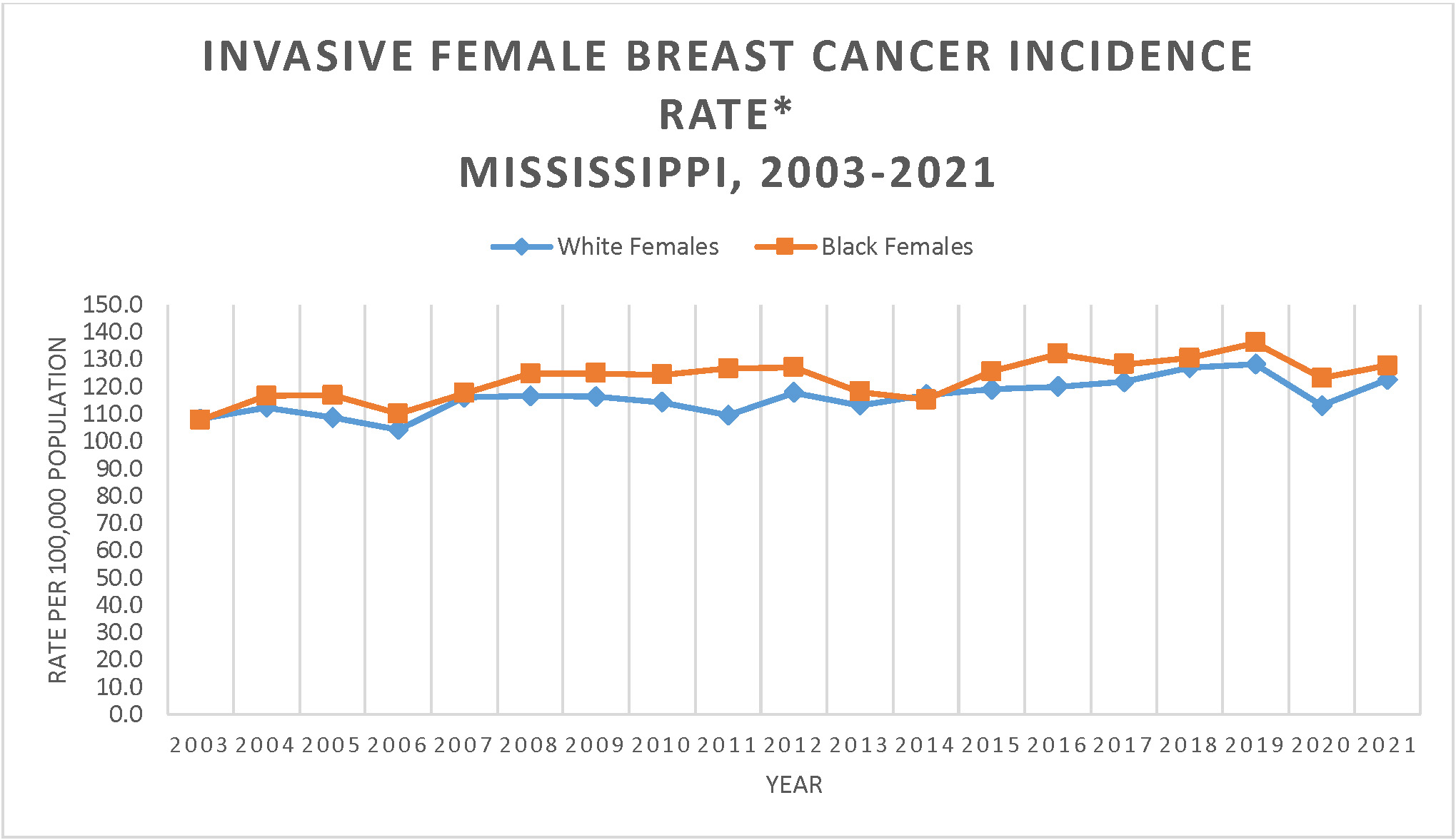
Overall, female breast cancer is associated with excessive alcohol use. In addition, post-menopausal breast cancer, which is defined as breast cancer diagnosed in women over the age of 50, is associated with both obesity and lack of physical activity. The rates of female breast cancer were similar between white and black females for most years. Both white and black females had a statistically significant annual increase between 2003 and 2021. The annual percent increase over that period for white females was 0.71% and the annual percent increase for black females was 0.77%. For the most recent five-year period between 2017 and 2021, both white and black females had an observed annual decrease. For white females, the observed decrease was 1.00% annually and for black females, the observed decrease was 0.63% annually.
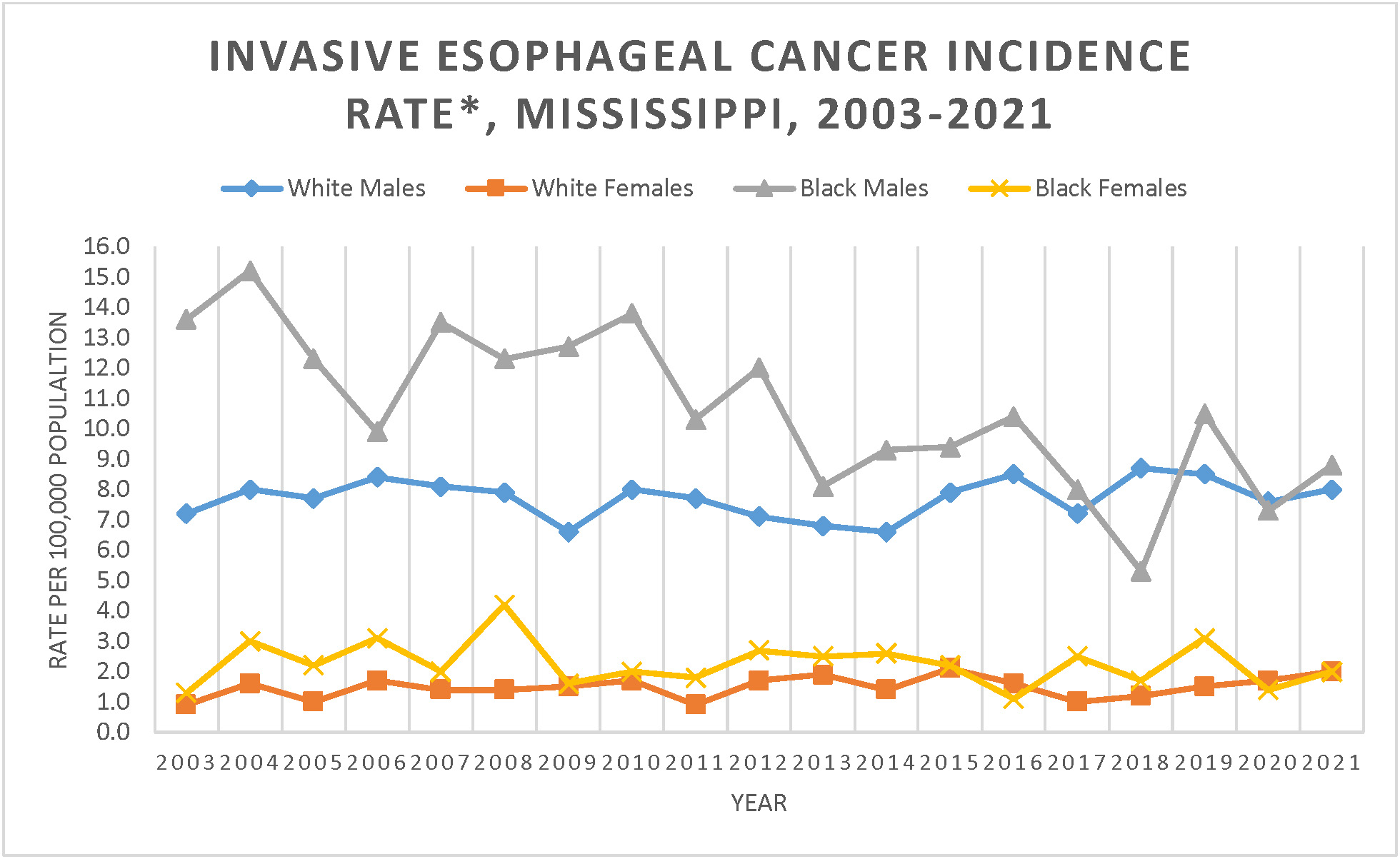
While esophageal cancer is associated with excessive alcohol use, it is also associated with another modifiable risk factor, tobacco use. Additionally, adenocarcinoma of the esophagus can be associated with obesity. Males had significantly higher rates of esophageal cancer than females. The rates were similar by race for females and similar for males beginning in 2013. The annual percent change over the period from 2003 to 2021 for black males and black females was statistically significant. For black males, the annual percent decrease was 3.27% and for black females was 1.52%. In contrast to black males and females, the rates for white males and white females increased, those the changes were not statistically significant. The rate for white females increased 1.36% annually and the rate for white males increased 0.24% annually.
For the latest five-year time period of 2017 to 2021, white males and black females had a similar trend to what was observed for the full time period of 2003 to 2021. The trend for 2017 to 2021 for white males was an annual increase of 0.51% and for black females was an annual decrease of 6.21%, neither of which were statistically significant. For black males, the trend for the most recent time period was opposite of the full time period from 2003 to 2021. For 2017-2021, black males experienced an observed increase of 4.50% annually. White females, similar to the full time period, experienced an increasing trend, however the change was statistically significant. For 2017-2021, the rate for white females increased at a rate of 18.56% annually.
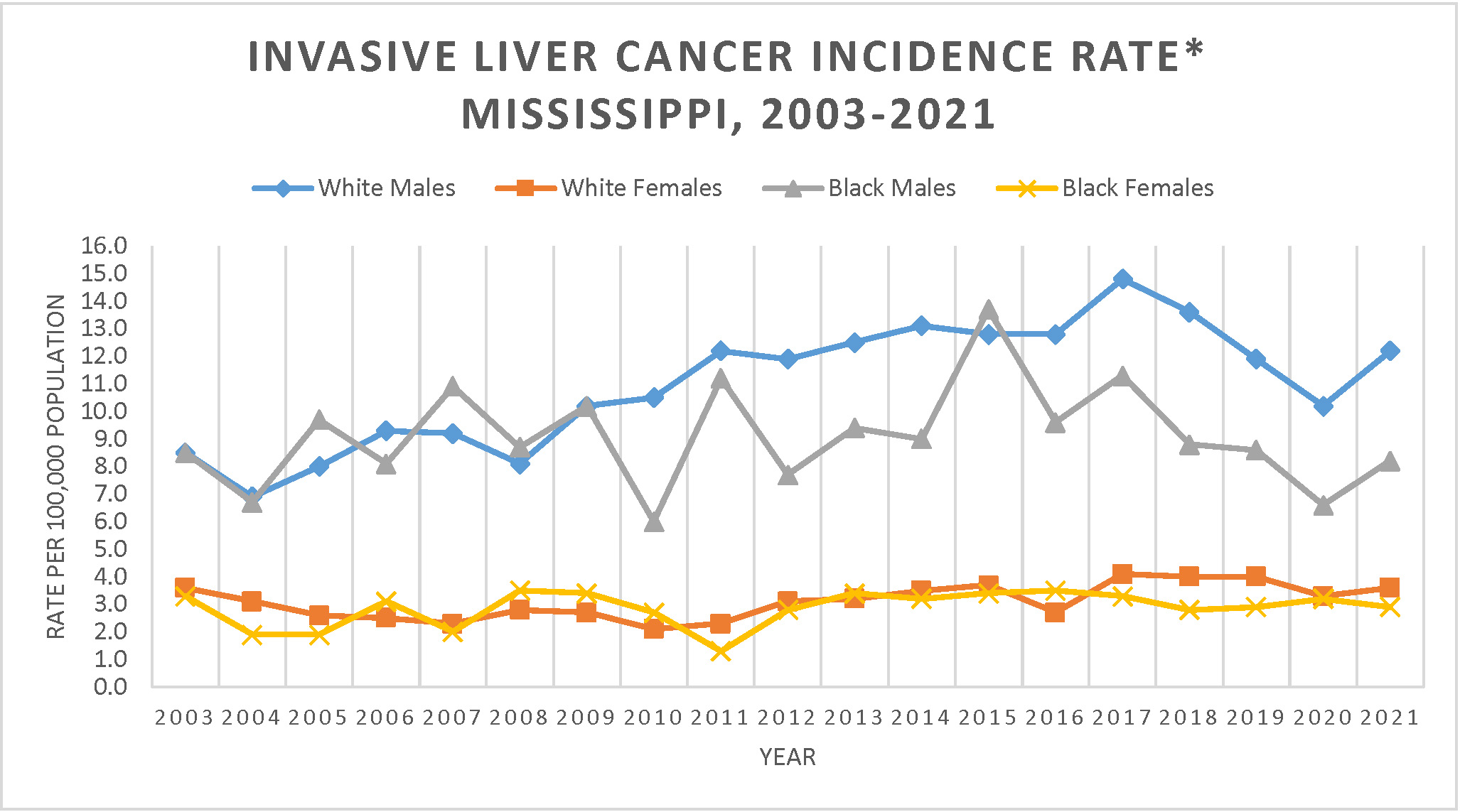
*Rates age-adjusted to the 2000 U.S. standard million population. Click here to read long description.
While liver cancer is associated with excessive alcohol use, it is also associated with two other modifiable risk factors, tobacco use and obesity. Males had significantly higher rates of liver cancer than females. The rates were similar between the races for females and for males prior to 2012. Beginning in 2012, white males had significantly higher rates that black males for many of those years. For white males, the incidence rate increased significantly between 2003 and 2017 at a rate of 4.58% annually. Between 2017 and 2021, the rate for white males decreased significantly at a rate of 6.65% annually. The rate for white females showed an annual decrease of 12.50% from 2003 to 2006, but then showed a significant increasing trend from 2006 to 2021 with an annual increase of 3.51%. The observed annual percent increase for black males was 0.10% and for black females was 1.19%.
For the latest five-year period of 2017 to 2021, trends were decreasing for all groups. For white males, the trend for the last five-year period was a decrease of 6.48% annually and for black males, the most recent trend observed was a decrease of 8.61% annually. For black females, the decrease was 1.47% annually and for white females, the decrease was 4.28% annually.
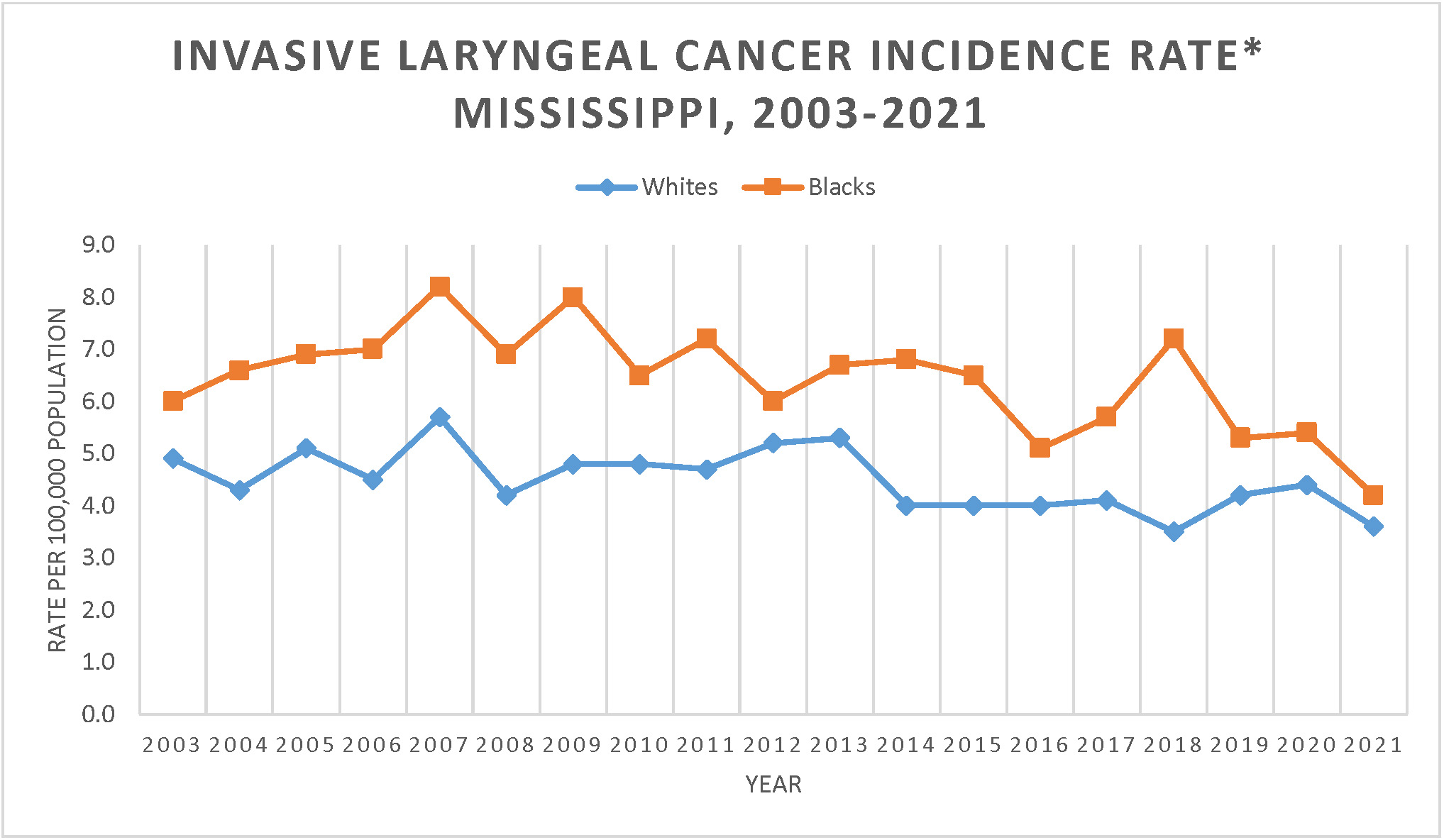
*Rates age-adjusted to the 2000 U.S. standard million population. Click here to read long description.
While laryngeal cancer is associated with excessive alcohol use, it is also associated with another modifiable risk factor, tobacco use. Laryngeal cancer is a relatively rare cancer. Thus, the rates could not be broken down by both race and sex. This graph only displays the rates by race. Over the period from 2003 to 2021, the significant annual decrease for the white population was 1.42%. For the black population, between 2003 and 2007, there was an annual observed increase of 6.68%. Between 2007 and 2021, the black population experienced a statistically significant decrease of 2.91% annually. For the latest five-year time period of 2017 to 2021, the black population and white population saw decreasing trends. These trends were not statistically significant. For the black population, the trend was an annual decrease of 8.52% and for the white population, the trend was an annual decrease of 0.05%.
Definitions
Age Adjusting: A statistical method that allows comparisons of populations that take into account age-distribution differences between the populations. The 2000 U.S. standard population is used and applied to all of the time periods being considered. This assures that the rates do not reflect differences in the age distribution of the population.
Annual Percent Change (APC): The average annual percent change over several years. It is used to measure the change in rates over time. Calculating the APC involves fitting a straight line to the natural logarithm of the data when it is displayed by calendar year.
Statistical Significance: This is a mathematical measure of the difference between groups. A difference is said to be statistically significant if it is greater than what might be expected to happen by chance alone 95% of the time. Rate ratios were used to assess the statistical significance between groups.
Citations
1 Centers for Disease Control and Prevention, National Center for Chronic Disease Prevention and Health Promotion, Division of Population Health. BRFSS Prevalence & Trends Data [online]. 2022. [accessed Jun 3, 2024]. URL: https://www.cdc.gov/brfss/brfssprevalence/.
2Surveillance Research Program, National Cancer Institute SEER*Stat software (seer.cancer.gov/seerstat) version 8.4.3.
Acknowledgement
We acknowledge the Centers for Disease Control and Prevention for their financial support under a cooperative agreement awarded to the Mississippi Cancer Registry.


